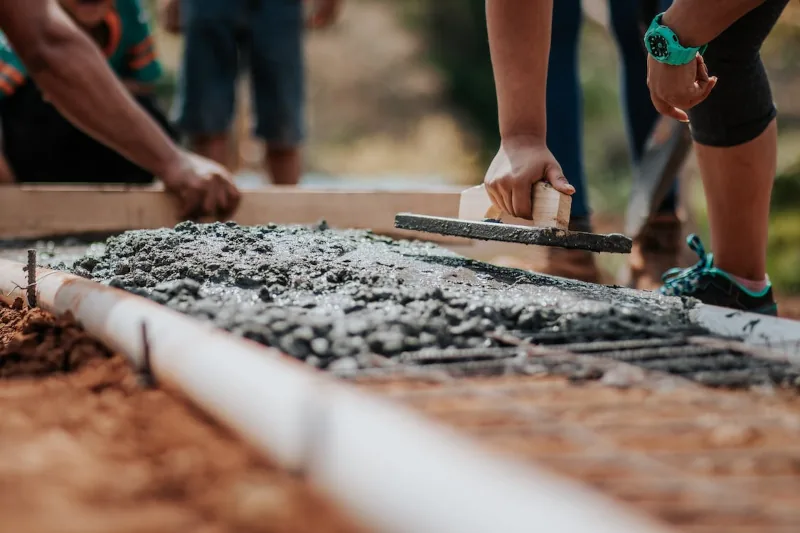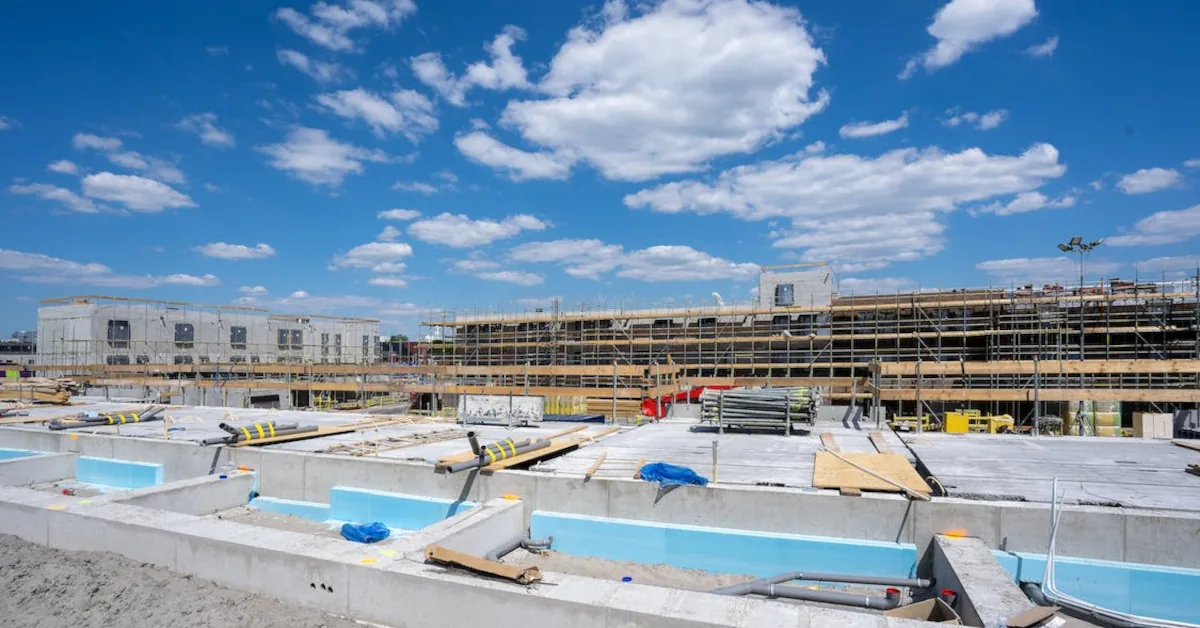RCC Full Form
I. What is the full form of RCC?
RCC stands for Reinforced Cement Concrete. It’s a composite material made from concrete and steel reinforcement. The steel reinforcement improves the strength and stability of the concrete.
RCC is used to construct various structures, including:
Water tanks, Dams, Bins, Silos, Bunkers, Bridges, Retaining walls, Underwater structures, Towers, Multi-storey buildings, Docks, Harbours.
RCC is made by embedding steel or iron bars in concrete before it sets up. The steel reinforcement makes the construction super strong and durable.
Concrete is good at resisting compression but is very weak at resisting tension. Wherever tensile stress is expected, reinforcement is provided in the concrete.
RCC is a composite material made of concrete and steel bars. It is one of the most important construction materials in civil engineering, used in a wide variety of structures, including buildings, bridges, dams, and tunnels.

II. Properties of RCC
A. Combination of Concrete and Steel Bars
RCC is a composite material that combines the best properties of concrete and steel. Concrete has high compressive strength, while steel has high tensile strength. When these two materials are combined in RCC, they create a material that is strong in both compression and tension.
This combination of properties makes RCC ideal for a wide variety of structural applications. For example, RCC columns are able to withstand heavy compressive loads, while RCC beams are able to withstand heavy bending loads. RCC slabs are able to withstand a combination of compressive and bending loads.
B. Castability into Any Shape
RCC is a very versatile material that can be cast into any shape. This makes it ideal for a wide variety of applications, from simple foundations to complex architectural structures.
The castability of RCC is due to the fact that concrete is a fluid material in its fresh state. This means that it can be poured into molds of any shape and will take the shape of the mold as it hardens. This makes RCC ideal for creating structures with complex shapes and geometries.
C. Resistance to Fire and Weather
RCC is resistant to fire and weather. This makes it a good choice for structures that are exposed to harsh environmental conditions.
The fire resistance of RCC is due to the fact that concrete is a non-combustible material. This means that it will not burn or support combustion. The weather resistance of RCC is due to the fact that it is a dense material that is not easily penetrated by water or other liquids.
D. Low Maintenance
RCC is a low-maintenance material. It does not require regular painting or other surface treatments.
The low maintenance requirements of RCC are due to the fact that it is a durable material that is resistant to weathering and degradation. However, it is important to note that RCC structures should be inspected regularly for signs of damage or deterioration.
E. Availability
RCC is a widely available material. As the RCC Full Form – Reinforced Cement Concrete suggests, the raw materials needed to produce RCC (cement, sand, aggregate, and steel) are available in most parts of the world.
The availability of RCC is one of its key advantages. This makes it a good choice for construction projects in any location.
F. Economical
RCC is an economical construction material. It is relatively inexpensive to produce and install.
The cost-effectiveness of RCC is due to the fact that the raw materials needed to produce it are widely available and relatively inexpensive. Additionally, RCC is a relatively easy material to work with, which helps to reduce labor costs.
G. Rigidity
RCC is a rigid material. This makes it a good choice for structures that need to withstand heavy loads.
The rigidity of RCC is due to the fact that it is a composite material made of concrete and steel. Concrete is a very rigid material, and steel is even more rigid. When these two materials are combined in RCC, they create a material that is extremely rigid.
III. Advantages of RCC
A. Good Durability
RCC structures are very durable. They can last for many years with proper maintenance.
The durability of RCC is due to the fact that it is a composite material made of concrete and steel. Concrete is a very durable material, and steel is even more durable. When these two materials are combined in RCC, they create a material that is extremely durable.
B. High Strength
RCC structures are very strong. They can withstand heavy loads and harsh environmental conditions.The strength of RCC is due to the fact that it is a composite material made of concrete and steel.
C. Versatility in Design
RCC can be cast into any shape, making it ideal for a wide variety of design applications.
RCC structures can be designed in a variety of shapes and sizes, from simple rectangular structures to complex structures with curved surfaces. This versatility is due to the fact that RCC is a fluid material in its fresh state. This means that it can be poured into molds of any shape and will take the shape of the mold as it hardens.
D. Resistance to Earthquakes
RCC structures are resistant to earthquakes. This is due to the fact that RCC is a ductile material, which means that it can deform without breaking.
Ductility is an important property for earthquake-resistant structures. When an earthquake occurs, the ground shakes and the structure is subjected to dynamic loads. These loads can cause the structure to deform. Ductile materials are able to deform without breaking, which allows them to absorb the energy from the earthquake and survive.
RCC is a ductile material because of the combination of concrete and steel. Concrete is a brittle material, but steel is a ductile material. The steel reinforcement in RCC provides the ductility that is needed to resist earthquakes.
E. Longevity
RCC structures have a long lifespan. With proper maintenance, RCC structures can last for centuries.
The longevity of RCC is due to the fact that it is a durable material that is resistant to weathering and degradation. Concrete is a very durable material, and steel is even more durable. When these two materials are combined in RCC, they create a material that is extremely durable.
In addition to the advantages listed above, RCC is also a relatively economical construction material. The raw materials needed to produce RCC (cement, sand, aggregate, and steel) are widely available and relatively inexpensive. RCC is also a relatively easy material to work with, which helps to reduce labor costs.
Overall, RCC is a versatile, durable, and economical construction material that is ideal for a wide variety of applications.
Also Read: https://www.egneva.com/best-quantity-surveyor-courses-in-calicut-kochi-and-trivandrum/
IV. Challenges of using RCC
Despite its many advantages, RCC also has some challenges. These challenges include:
- Longer construction time: RCC structures require a longer construction time than other types of structures, such as steel structures.
- Slow strength gain: RCC takes time to gain its full strength.
- Need for proper quality control and durability considerations: RCC structures need to be properly designed and constructed to ensure durability. This means that it is important to use high-quality materials and to follow proper construction practices.
Despite these challenges, RCC remains one of the most widely used construction materials in the world. This is due to its many advantages, such as its strength, durability, versatility, and economy.
V. Conclusion
So, What is the full form of RCC? – RCC stands for Reinforced Cement Concrete. It is a durable construction material that is essential for modern civil engineering. It is used in a wide variety of structures, including buildings, bridges, tunnels, dams, and reservoirs.
RCC has a number of advantages over other construction materials, including:
- High strength and durability
- Versatility in design
- Resistance to earthquakes
- Longevity
However, RCC also has some challenges, such as longer construction time, slow strength gain, and the need for proper quality control and durability considerations.
Despite its challenges, RCC remains one of the most widely used construction materials in the world. This is due to its many advantages and its essential role in modern civil engineering.
Researchers are constantly working to develop new RCC mixes with improved strength and durability, new steel reinforcement materials with improved strength and corrosion resistance, and new construction methods that are more efficient and sustainable.

